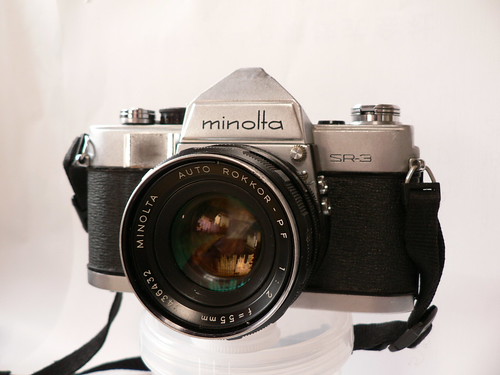Difference between revisions of "Minolta SR-3"
m (→Links) |
(contrib txt) |
||
| Line 1: | Line 1: | ||
<div class="floatright"> [http://www.flickr.com/photos/agricola/249385989/ http://static.flickr.com/83/249385989_1890eb0d17.jpg]</div> | <div class="floatright"> [http://www.flickr.com/photos/agricola/249385989/ http://static.flickr.com/83/249385989_1890eb0d17.jpg]</div> | ||
| − | The '''Minolta SR-3''' was the | + | The '''Minolta SR-3''' was launched in 1960 as the third 35mm [[SLR]] camera from [[Minolta]]. It replaced the [[Minolta SR-2|SR-2]], and was in turn replaced, in 1962, by the venerable [[Minolta SR-7]] which was the first 35mm SLR camera with a built-in CdS-[[light meter|exposure meter]]. One of the standard lenses soon available would be the impressive Auto Rokkor-PF 1:1.4 f=58mm with depth-of-field pre-view stop-down lever. Chiyoda Kogaku was one of the very few Japanese camera makers who actually made the optical glasses for their lenses themselves. |
| − | + | Improvements made on the SR-3 as compared to the SR-2: | |
| − | * | + | *Prepared for the Minolta clip-on [[selenium]] [[light meter]] by introducing a bracket on the camera body front and a shutter-speed dial coupling pin. |
| − | * | + | *The bayonet mount surrounding the viewfinder was introduced. |
| − | *Split image focusing. | + | *Split image focusing screen. |
| − | The early version of SR-3 still featured the semi automatic diaphragm as the SR-2 (stops down | + | As with its predecessors, the SR-3 was subject to improvements in the course the production run. The early version of SR-3 still featured the semi automatic diaphragm as the SR-2 (stops down at shutter release, opens up when winding the camera on). The late version, introduced in 1961, featured the new fully automatic diaphragm, opening the lens instantly after the exposure. This late camera version was also available in black. |
Revision as of 05:38, 27 May 2009
The Minolta SR-3 was launched in 1960 as the third 35mm SLR camera from Minolta. It replaced the SR-2, and was in turn replaced, in 1962, by the venerable Minolta SR-7 which was the first 35mm SLR camera with a built-in CdS-exposure meter. One of the standard lenses soon available would be the impressive Auto Rokkor-PF 1:1.4 f=58mm with depth-of-field pre-view stop-down lever. Chiyoda Kogaku was one of the very few Japanese camera makers who actually made the optical glasses for their lenses themselves.
Improvements made on the SR-3 as compared to the SR-2:
- Prepared for the Minolta clip-on selenium light meter by introducing a bracket on the camera body front and a shutter-speed dial coupling pin.
- The bayonet mount surrounding the viewfinder was introduced.
- Split image focusing screen.
As with its predecessors, the SR-3 was subject to improvements in the course the production run. The early version of SR-3 still featured the semi automatic diaphragm as the SR-2 (stops down at shutter release, opens up when winding the camera on). The late version, introduced in 1961, featured the new fully automatic diaphragm, opening the lens instantly after the exposure. This late camera version was also available in black.
Links
- The SR-3 page at the Manual Minolta website
- Black SR-3 at Syoji Nishidas website
- Minolta SR-3 on www.collection-appareils.fr by Sylvain Halgand
| Minolta Classic Cameras |
|---|
| Vest (or Best) | V2 | SR-2 | SRT 101 | XE | XD | CLE | 7000 | 9000 | 800 si |
